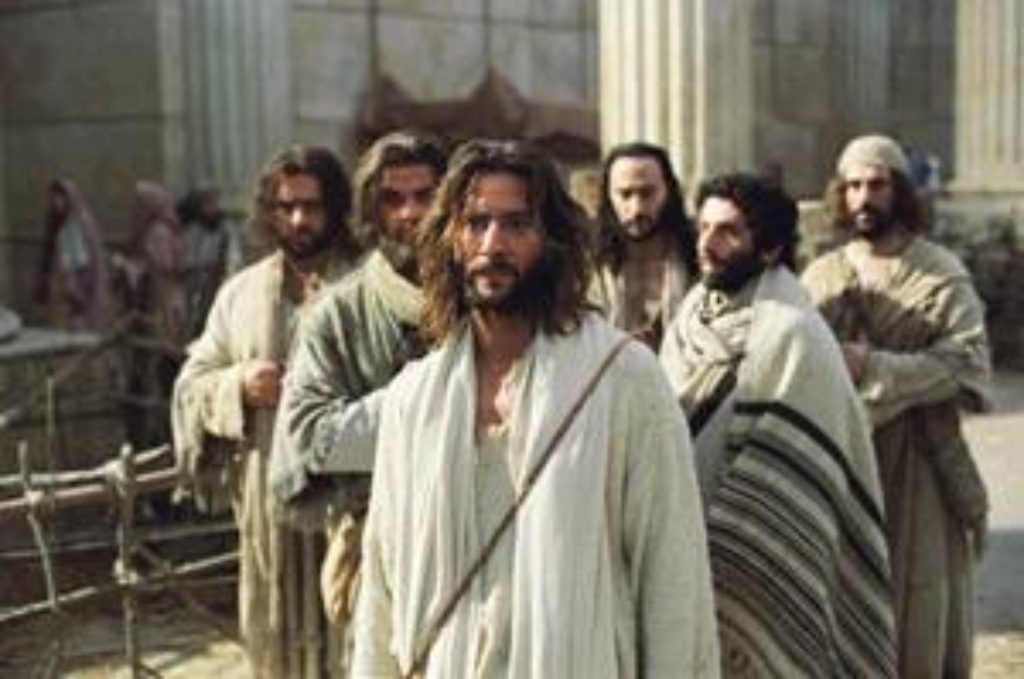
If you own a copy of the Good News Bible, you’ve probably already read the entire script of The Gospel of John. Narrator Christopher Plummer opens at John 1:1’s “Word of Life” passage, quickly setting the scriptural tone of authority carried throughout the three-hour epic.
Unlike the other three gospel accounts that begin with the birth of Christ, John enters the greatest story ever told at the ministry of John the Baptist, the wild-haired prophet of the desert called to prepare the way of the Lord. Onscreen, as in scripture, it’s John who introduces us to Jesus. Moviegoers are then invited to walk with Christ as he calls his disciples, first teaching them, and then the masses, about himself and the kingdom of heaven.
Proceeding with Jesus down the road to Calvary, we witness his miracles and skillful avoidance of an increasingly threatening pack of Jewish religious leaders. Indeed, the movie’s masterful depiction of the political and religious climate of the day sets it apart from others in its genre. When The Gospel of John’s narrative arrives at Golgotha, it packs in plenty of passionate intensity, but skirts the gory realism contained in Mel Gibson’s The Passion of the Christ. It then places the crucifixion in context by taking the time to show Jesus’ glorious resurrection and last days with his disciples before returning to his Father in heaven.
The filmmakers set the lofty goal of trying to let The Gospel of John “speak for itself without additional material from other gospels and without omitting anything.” Nonverbal communication allows us to also witness the dawning of faith on doubting Thomas’s face at the post-resurrection appearance of Jesus. Mary’s anguish as she looks up from the foot of the cross. And a tender moment from Jesus’ childhood.
Henry Ian Cusick’s powerful portrayal of God Who Became Man is the movie’s pivot point. Moving effortlessly from the enraged Son cleansing his Father’s temple, to the humble Servant-Master washing his disciples’ feet, Cusick’s range becomes increasingly evident as the minutes tick by. Daniel Kash gives a convincing performance as the impetuous, passionate Peter, whose final scene of restoration by Jesus at the beachside barbeque provides a satisfying spiritual and emotional closure.
Because the movie is “scripture unscripted,” it is in essence purely spiritual and as such holds great potential as an evangelistic tool—a fact that screenwriter John Goldsmith understood full well. In an interview captured on the DVD, he says, “Real miracles happen off camera.”
The effort to authentically dramatize Scripture includes both visual and auditory representations. Period costumes are convincing. Even the musical score, performed by the London Philharmonic Orchestra, is accentuated by ancient instruments and Aramaic chants.
Dialogue only. Jesus interacts with the Samaritan woman at the well (John 4) and rebuffs those who would stone a woman caught in adultery (John 8).
Mel Gibson’s Passion is known for its extreme gore; John’s violence is understated without being whitewashed. When Jesus wields a whipcord in the temple, it’s used strictly for dramatic emphasis and doesn’t actually strike man or beast. When he is scourged by the Romans, we see the whip’s shadow descending behind prison bars, but don’t see it make contact. Likewise, at the crucifixion, we understand the nails have been driven into Jesus’ hands without witnessing their penetration. We see his bloody body hanging on the cross, but the camera doesn’t linger.
None.
Jesus changes water into wine at the wedding of Cana. (We see guests enjoying themselves, but none of them appear to be inebriated.) Wine is served at the last supper. Jesus drinks from a wine-soaked sponge while hanging on the cross.
Some Christians may take issue with Mary Magdalene’s silent presence at Christ’s last supper with his disciples (it’s not noted anywhere in scripture). Explaining his decision to include her (in a DVD interview), director Philip Saville states his belief that “Mary Magdalene was the first female disciple.” The movie could be seen as assigning her the place vacated by the traitor Judas, moving with the disciples from the upper room, witnessing Jesus’ arrest and staying with the group through the final scene.
Some of The Gospel of John‘s performances are weakened by hesitant acting, inconsistent accents and Western facial features (who knew there were so many blue-eyed Jews?). The female characters—particularly Mary Magdalene and Mary, the mother of Jesus—look more like Iowans than Israelis. That doesn’t, however, prevent this poignant movie from providing a fresh, powerful and honest look at the life of Christ, promising rich reward for those willing to withstand its long presentation. (Clocking in at three hours, the film’s pace is more easily adapted to episodic Bible studies, family nights and devotions than a Friday “movie night.” Special DVD features add educational value and include an interactive map, historical background, political and cultural insights, interviews and instructional pop-ups.)
Despite its undeserved PG-13 rating for crucifixion violence, this film is suitable for viewing by all but the youngest and most sensitive children. Its greatest asset is its evangelistic potential. If any viewer is left doubting that Jesus Christ was and is the Son of God, it is no fault of The Gospel of John.